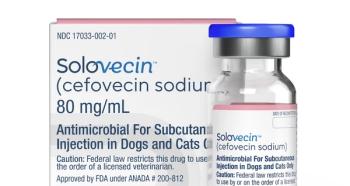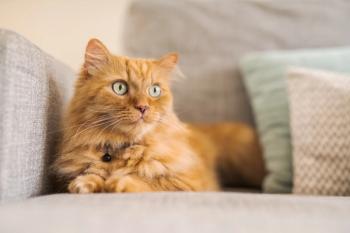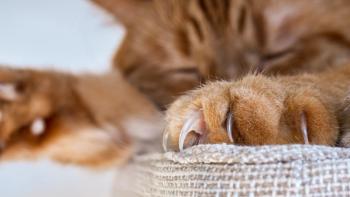
Weight management for the fat feline (Proceedings)
The fat feline is a problem all practitioners face.
The fat feline is a problem all practitioners face. Clients often believe that a fat cat is a healthy and happy cat. They are more likely to bring the cat in for an exam due to poor appetite rather than overeating and obesity concerns. The focus of this lecture will be to discuss integrating weight management into your medical care program. The goal is to control the eating habits, diet and exercise of the cat before obesity develops (good habits, good health) and to regain control once a weight problem has developed.
Start early.
The client relies on you to make diet recommendations based on what that kitten or cat needs. Start at a young age. Promote the diets you endorse and recommend a specific amount of food based on that cat's caloric needs. As those needs change, reevaluate the diet. Make sure you get a dietary history at each visit.
Don't lose track of the kitten after it is spayed or neutered. This time period is a critical growth period and is often overlooked. Many pets start developing a tendency towards obesity at this point.
Encourage weigh-ins.
Make it easy for the client to stop in with the cat and get the weight checked. Make sure this weight is recorded in the patient's chart so it can be accurately followed. Use your computer recall system to flag records of patients that have not been in recently (at least yearly if not every 6 months). Call and check on the patient. Encourage a visit – at least a weight check.
Use a body condition scoring system and record body circumference measurements at each physical examination.
Body condition scores make you commit to a number for that pet's condition based on their weight and overall appearance. The Purina system (1-9) allows for more flexibility with its wider range of numbers. The body scoring system is a well-defined program that promotes continuity among all the doctors in the practice. It is also be a good idea to record body circumference measurements (axilla, ribs, flank) as you may see changes in these areas before any changes in the body weight or body condition score.
Discuss the patient's activity level at each visit.
Become familiar with the pet's daily routine. Recommend ways to encourage activity, especially as pets get older. Sedentary pets are at higher risk of obesity. Be sure to address any pain/arthritis issues that might be limiting the pet's normal activity. Develop as exercise program for the cat. This may be as simple as placing the cat's food in high and low places around the house, making the cat hunt for the food and move around.
Be sensitive but concerned and persistent in regards to the pet's weight problem.
The quickest way to alienate a client is to make fun of their "fat cat". Educate the client about the health risks associated with obesity in cats. Share your concerns, and follow these concerns with a defined plan to encourage weight loss. Encourage the client with success stories of other patients. Until the client agrees that weight loss is important, repeat your concerns and recommended plan at each visit.
Make the weight loss plan simple and clear.
The plan needs to be recorded in the patient's medical record, and the client should receive a copy of the plan. Discuss the plan with the client and make sure everyone in the pet's family is supportive of the plan. Have a defined amount of food to feed based on the pet's caloric and protein needs. Develop some type of exercise program. Nip bad habits (snacking) in the bud.
Handouts are helpful to the client.
In addition to the weight loss plan, handouts on body condition scores and the available weight loss diets should be given to the client. Informative articles about obesity in pets may help encourage the client to follow through with the plan. Education is an important component of the weight loss program.
Your recommendations should be echoed by all employees.
All employees in the practice need to be informed about and supportive of the weight management program. It is a good idea to spend time teaching your staff everything they need to know about the program. An educated staff will be more able and willing to help implement the program. The staff can serve as the support group for the pet (and client).
Example of a weight reduction worksheet:
Client:
Patient:
Date:
Reason for weight reduction plan:
1. Calculate Basal Energy Requirement (BER) based on ideal body weight.
Animal less than 2 kg body weight: 70(body weight in kgs)0.75 = BER kcal/day
Animal more than 2 kg body weight: 30(body weight in kgs) + 70 = BER kcal/day
2. Calculate Maintenance Energy Requirement (MER) based on ideal body weight.
Cats 1.2 x BER = ideal MER kcal/day
3. Calculate energy intake for moderate caloric restriction.
Cats 70% x ideal MER kcal/day = adjusted MER kcal/day
4. Calculate food dose based on caloric density of diet.
Name of diet chosen:
Adjusted MER / caloric density = food dose/day
5. Estimate time for weight loss to be achieved.
Obese weight kg - ideal weight kg = excess body fat kg
Excess body fat kg x 7700 kcal/kg = excess storage calories kcal
Ideal MER – adjusted MER = caloric deficit kcal/day
Excess storage calories / caloric deficit = days required for planned weight loss
Dietary protein intake: 2 grams/lb body weight per day for cats to maintain positive nitrogen balance.
Grams protein per 100 kcal in diet chosen:
Do not weigh your pet more than once a week. Cut out all snacks. If you must feed your pet treats, use kibbles from a portion of the calculated amount of food.
Good websites:
Selected readings:
Burkholder WJ, Bauer JE: Foods and techniques for managing obesity in companion animals. J Am Vet Med Assoc 212:658-662, 1998.
Fettman MJ, Stanton CA, Banks LL et al: Effects of neutering on body weight, metabolic rate and glucose tolerance of domestic cats. Res Vet Sci 62:131-136, 1997.
Laflamme DP: Nutrition for aging cats and dogs and the importance of body condition. Vet Clin North Am 35:713-742, 2005.
Laflamme DP, Hannah SS. Increased dietary protein promotes fat loss and reduces loss of lean body mass during weight loss in cats. Intern J Appl Res Vet Med 3:62-68,2005.
Scarlett JM, Donaghue S: Obesity in cats: prevalence and prognosis. Vet Clin Nutr 3:128, 1996.
Scarlett JM, Donaghue S: Associations between body condition and disease in cats. J Am Vet Med Assoc 212:1725-1731,1998.
Sloth C: Practical management of obesity in dogs and cats. J Sm An Pract 33:178-182, 1992.
Szabo J, Ibrahim WH, Sunvold GD, et al: Influence of dietary protein and lipid on weight loss in obese ovariohysterectomized cats. Am J Vet Res 61:559-565, 2000.
Newsletter
From exam room tips to practice management insights, get trusted veterinary news delivered straight to your inbox—subscribe to dvm360.






